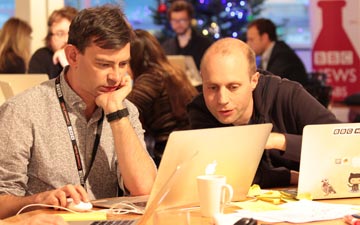
London meeting focuses on identifying trustworthy news
Earlier this month, the Markkula Center for Applied Ethics and the BBC collaborated to host The Trust Project Challenge, an international gathering of reporters, editors, and technologists to come up with technological tools that can increase trust among readers. The Challenge capped a yearlong series of discussions between media outlets and platforms about the elements of quality journalism and how to signal them to readers.
The project addresses some of the problems like fake news that have bedeviled public discourse. Participant Denise Law, community editor at The Economist, described the event:
So, what can be done to rebuild the public’s trust in mainstream news? That is the question that more than a dozen publishers tried to answer at a two-day hackathon in London as part of Santa Clara University’s Trust Project Challenge. The Trust Project aims to develop tools and technologies that can help news users differentiate between authentic and inauthentic news, and to help newsrooms to stand out from the noise online, primarily with the help of "trust indicators.”
Law worked on an open-source webpage validator that would allow visitors to a new site to see score "based on how much information the publisher has disclosed about itself in the code of its web page (see below for mockups)," she explained.
Jane Wakefield covered the event for the BBC. She reported:
- Mirror Group developed a tool that identifies whether an organisation sticks to the Trust Project guidelines as well as information about the author of a news story.
- La Stampa developed a tool that identifies the level of trust that the author enjoys by looking at how many similar stories they have written.
- WashingtonPost/BuzzFeed developed a tool that scans articles to find links and sources and makes this information visible to readers.
- BBC News Labs came up with a way to make the information that journalists collect as they are researching a story visible to readers.
- The Guardian: A tool designed to get people out of their filter bubbles, by offering articles that give an opposing view alongside the articles users choose to read.
Photo Credit: Chris Ambrose, BBC
